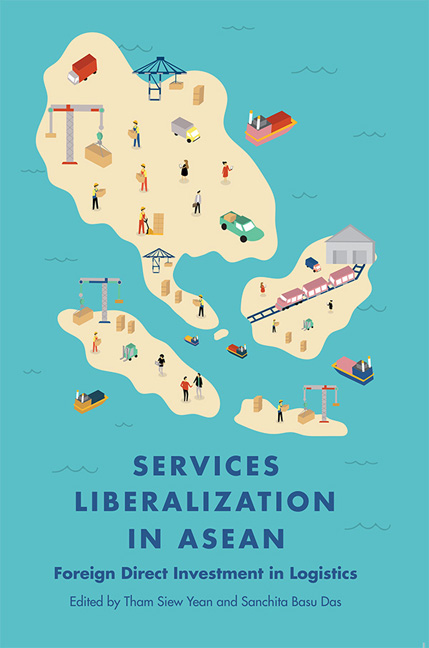Book contents
- Frontmatter
- CONTENTS
- List of Tables
- List of Figures
- Foreword
- Preface
- Acknowledgements
- Abbreviations
- About the Contributors
- 1 Introduction
- 2 Reforming Indonesia's Logistics Sector
- 3 FDI Liberalization in Malaysia's Logistics Services
- 4 Logistics Services Liberalization in the Philippines
- 5 Services Sector Liberalization in Singapore: Case of the Logistics Sector
- 6 Logistics Services Liberalization in Thailand
- 7 Services Liberalization in Vietnam: The Case of FDI in Logistics Sector
- 8 Services Liberalization: Case of Logistics in Brunei
- 9 FDI, Services Liberalization and Logistics Development in Cambodia
- 10 Services Liberalization in Lao PDR: FDI in Logistics Sector of a Land-linked Country
- 11 Facilitating FDI for the Logistics Sector in Myanmar: Agency, Incentives, and Institutions
- Index
5 - Services Sector Liberalization in Singapore: Case of the Logistics Sector
Published online by Cambridge University Press: 04 July 2018
- Frontmatter
- CONTENTS
- List of Tables
- List of Figures
- Foreword
- Preface
- Acknowledgements
- Abbreviations
- About the Contributors
- 1 Introduction
- 2 Reforming Indonesia's Logistics Sector
- 3 FDI Liberalization in Malaysia's Logistics Services
- 4 Logistics Services Liberalization in the Philippines
- 5 Services Sector Liberalization in Singapore: Case of the Logistics Sector
- 6 Logistics Services Liberalization in Thailand
- 7 Services Liberalization in Vietnam: The Case of FDI in Logistics Sector
- 8 Services Liberalization: Case of Logistics in Brunei
- 9 FDI, Services Liberalization and Logistics Development in Cambodia
- 10 Services Liberalization in Lao PDR: FDI in Logistics Sector of a Land-linked Country
- 11 Facilitating FDI for the Logistics Sector in Myanmar: Agency, Incentives, and Institutions
- Index
Summary
Introduction
Singapore's economy has been growing at a tepid pace since 2012 due to a modest performance of the US economy, uncertainties surrounding the European Union (EU), weak growth in the East Asian region, particularly with China's structural economic slowdown and, a general slowdown in global trade. During 2011–16, Singapore's real Gross Domestic Product (GDP) grew at an average rate of 3.8 per cent per annum, compared to an average of 7.3 per cent during 2002–7 (Singapore Department of Statistics 2017a). The lackluster output is matched by an unemployment rate of around 2 per cent during 2011–16 (Singapore Department of Statistics 2017b). It has been estimated that the economy will grow at a rate of 1–3 per cent in 2016 (Ministry of Trade and Industry Singapore 2017).
It is during this time of restrained economic outlook that Singapore is also undergoing a structural adjustment. In 2010, the city-state embarked on a ten-year programme to boost its productivity growth to 2 to 3 per cent per annum, from around 1 per cent during the 2000s (Economic Strategies Committee 2010). The target was to be achieved by curbing the growth of low-skilled foreign labour supply, encouraging capital deepening and increasing automation. Programmes were put in place to help the local workforce to develop new skills according to new growth areas. While the manufacturing sector had undergone restructuring several times in past decades, it was the first time the entire economy was subject to such a process. Since then, this strive for transformation has been a challenge for domestic-oriented businesses, particularly those in the services sector, which are trying hard to lower their dependence on foreign labour and re-position themselves by investing in technology and talent (Menon 2015).
A further policy boost came in February 2017, when Singapore released the Committee on the Future Economy (CFE) Report that laid down seven strategies to secure the city-state's economic success over the longer term.
- Type
- Chapter
- Information
- Services Liberalization in ASEANForeign Direct Investment in Logistics, pp. 148 - 180Publisher: ISEAS–Yusof Ishak InstitutePrint publication year: 2017



